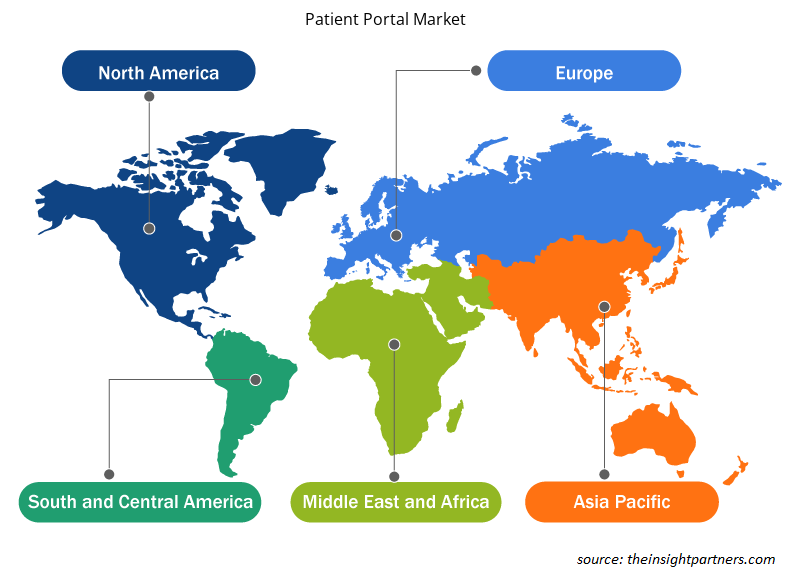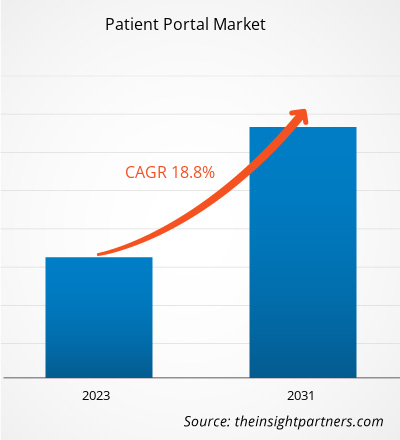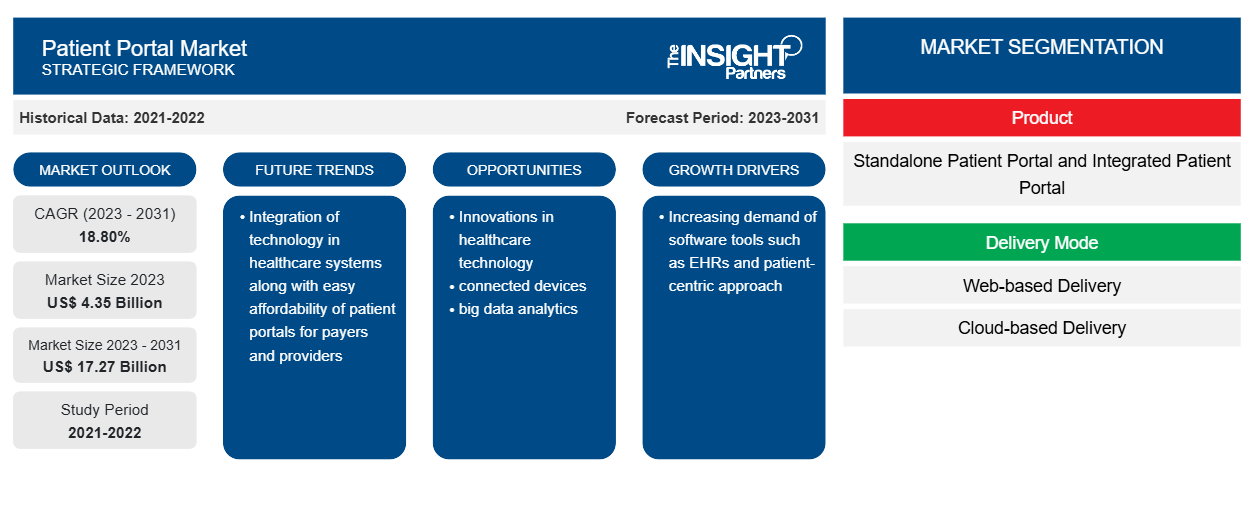Le marché des portails patients devrait atteindre 17,27 milliards USD d'ici 2031, contre 4,35 milliards USD en 2023. Le marché devrait enregistrer un TCAC de 18,80 % au cours de la période 2023-2031. L'adoption croissante de l'approche centrée sur le patient par les payeurs de soins de santé et la demande croissante de dossiers médicaux électroniques (DME) pour améliorer l'engagement des patients devraient rester des tendances clés sur le marché des portails patients.
Analyse du marché des portails patients
Les patients accèdent à leur dossier médical électronique (DME), un outil potentiel pour affiner l'engagement des patients, via des portails en ligne. Avec l'expansion des interfaces de programmation pour augmenter le flux de données bidirectionnel avec les patients et simplifier l'accès aux données des patients telles que les notes cliniques , l'impact potentiel de l'engagement des patients avec la mise en œuvre de ces plateformes devrait augmenter dans les années à venir. Environ 90 % des systèmes et prestataires de soins de santé américains offrent aux patients un accès en ligne à leurs données de DME, selon les données extraites des Annals of Internal Medicine en 2020. Cependant, seulement 15 à 30 % des patients utilisent ces plateformes. L'utilisation d'un portail patient est limitée à des contextes spécifiques tels que les soins ambulatoires dans un système de prestation intégré.
Aperçu du marché des portails patients
L'Amérique du Nord est le plus grand marché pour la croissance du marché des portails patients, les États-Unis détenant la part de marché la plus importante dans la région, suivis du Canada. Avec la croissance de la numérisation dans le secteur de la santé, l'utilisation des DSE augmente rapidement. Selon les données présentées par l'OMS, les systèmes nationaux de DSE sont mis en œuvre par environ 50 % du total des pays du monde. En outre, un article publié dans le Journal of Health Affairs Scholar en octobre 2023 indiquait que les grands hôpitaux ont un taux d'adoption de DSE complet d'environ 7 % supérieur à celui des hôpitaux de taille moyenne, soit plus de 34 %. Cependant, les hôpitaux ruraux sont à la traîne des zones urbaines en matière d'adoption de DSE complet, de 12 %. Le besoin croissant de DSE et l'intégration croissante de techniques centrées sur le patient par les payeurs de soins de santé sont quelques-uns des facteurs contribuant à la croissance du marché des portails patients aux États-Unis.
Personnalisez ce rapport en fonction de vos besoins
Vous bénéficierez d'une personnalisation gratuite de n'importe quel rapport, y compris de certaines parties de ce rapport, d'une analyse au niveau des pays, d'un pack de données Excel, ainsi que d'offres et de remises exceptionnelles pour les start-ups et les universités.
-
Obtenez les principales tendances clés du marché de ce rapport.Cet échantillon GRATUIT comprendra une analyse de données, allant des tendances du marché aux estimations et prévisions.
Facteurs moteurs et opportunités du marché des portails patients
Adoption croissante d'une approche centrée sur le patient par les organismes payeurs de soins de santé
Les portails patients sont un outil important pour les solutions d'engagement des patients. Cette solution gagne en popularité en termes d'utilisation auprès de la population vieillissante. Les fabricants de logiciels développent ce portail patient sous la forme d'applications Web ou mobiles. Sur ce portail, les patients peuvent facilement enregistrer et accéder à leurs données. De plus, les gouvernements de divers pays du monde entier se concentrent sur l'établissement de réglementations, d'infrastructures et de normes pour la tenue des dossiers médicaux. Par exemple, la plateforme My Health Record, la plateforme nationale australienne de dossiers médicaux numériques, a été développée pour sécuriser les propres dossiers médicaux des patients en 2022. Les patients australiens titulaires de Medicare ou d'un identifiant individuel de soins de santé (IHI) peuvent utiliser My Health Record. L'utilisation de telles plateformes de santé numériques par les prestataires de soins de santé peut faciliter la récupération des données de santé stockées sur la plateforme. Ainsi, l'adoption croissante d'une approche centrée sur le patient par les payeurs de soins de santé stimule le marché des portails patients.IHI) can use My Health Record. The use of such digital health platforms by healthcare providers can facilitate the retrieval of healthcare data stored on the platform. Thus, the rising adoption of a patient-centric approach by healthcare payers drives the patient portal market.
Augmentation des dépenses de santé consacrées aux solutions de santé numériques
Les prestataires de soins de santé reconnaissent l’importance de mettre en œuvre des solutions efficaces et centrées sur le patient. Les fournisseurs de logiciels et les institutions de recherche investissent dans les technologies de santé numérique pour améliorer l’engagement des patients et rationaliser les processus administratifs. Les portails patients sont devenus un élément clé des solutions de santé numérique, offrant une plate-forme sécurisée et accessible permettant aux patients d’accéder à leurs informations de santé et de communiquer avec les prestataires de soins de santé. Les investissements dans ces portails patients sont motivés par la capacité à réaliser des économies de coûts grâce à une meilleure coordination des soins et à de meilleurs résultats pour les patients. L’augmentation des dépenses de santé consacrées aux solutions de santé numérique devrait créer des opportunités lucratives pour la croissance du marché des portails patients au cours de la période de prévision.
Analyse de segmentation du rapport sur le marché des portails patients
Les segments clés qui ont contribué à l’élaboration de l’analyse du marché du portail patient sont les services, les prestataires de services et les utilisateurs finaux.
- En fonction du produit, le marché des portails patients est segmenté en portails patients autonomes et portails patients intégrés. Le segment des portails patients intégrés détenait une part de marché plus importante en 2023. Le portail patient intégré fonctionne comme un module ajouté à un DSE/DME complémentaire ou à tout autre système de santé.
- Selon le mode de livraison, le marché est divisé en modes basés sur le Web et sur le cloud. Le segment du mode basé sur le Web détenait une part plus importante du marché en 2023. Le mode basé sur le cloud devrait enregistrer un TCAC plus élevé au cours de la période 2023-2031.
- En fonction de l'utilisateur final, le marché est segmenté en payeurs, prestataires, pharmacies et autres. Le segment des prestataires détenait la plus grande part du marché en 2023. Ce segment comprend les hôpitaux, les centres de soins ambulatoires et les maisons de retraite.
Analyse des parts de marché du portail des patients par zone géographique
La portée géographique du rapport sur le marché du portail patient est principalement divisée en cinq régions : Amérique du Nord, Asie-Pacifique, Europe, Moyen-Orient et Afrique, et Amérique du Sud et centrale.
L'Amérique du Nord domine le marché des portails patients. La croissance du marché peut être attribuée à l'augmentation des dépenses de recherche et développement du gouvernement pour les établissements hospitaliers en Amérique du Nord et à l'adoption croissante des portails patients par les sociétés biotechnologiques et pharmaceutiques.
Portail des patients
Informations régionales sur le marché des portails patients
Les tendances et facteurs régionaux influençant le marché des portails patients tout au long de la période de prévision ont été expliqués en détail par les analystes d’Insight Partners. Cette section traite également des segments et de la géographie du marché des portails patients en Amérique du Nord, en Europe, en Asie-Pacifique, au Moyen-Orient et en Afrique, ainsi qu’en Amérique du Sud et en Amérique centrale.

- Obtenez les données régionales spécifiques au marché des portails patients
Portée du rapport sur le marché des portails patients
| Attribut de rapport | Détails |
|---|---|
| Taille du marché en 2023 | 4,35 milliards de dollars américains |
| Taille du marché d'ici 2031 | 17,27 milliards de dollars américains |
| Taux de croissance annuel composé mondial (2023-2031) | 18,80% |
| Données historiques | 2021-2022 |
| Période de prévision | 2023-2031 |
| Segments couverts |
Par produit
|
| Régions et pays couverts |
Amérique du Nord
|
| Leaders du marché et profils d'entreprises clés |
|
Densité des acteurs du marché des portails patients : comprendre son impact sur la dynamique commerciale
Le marché des portails patients connaît une croissance rapide, tirée par la demande croissante des utilisateurs finaux en raison de facteurs tels que l'évolution des préférences des consommateurs, les avancées technologiques et une plus grande sensibilisation aux avantages du produit. À mesure que la demande augmente, les entreprises élargissent leurs offres, innovent pour répondre aux besoins des consommateurs et capitalisent sur les tendances émergentes, ce qui alimente davantage la croissance du marché.
La densité des acteurs du marché fait référence à la répartition des entreprises ou des sociétés opérant sur un marché ou un secteur particulier. Elle indique le nombre de concurrents (acteurs du marché) présents sur un marché donné par rapport à sa taille ou à sa valeur marchande totale.
Les principales entreprises opérant sur le marché des portails patients sont :
- Société Cerner,
- Allscripts Soins de santé,
- Société Epic System,
- Voie Verte,
- athenasanté
- CureMD Soins de santé
Avis de non-responsabilité : les sociétés répertoriées ci-dessus ne sont pas classées dans un ordre particulier.

- Obtenez un aperçu des principaux acteurs clés du marché des portails patients
Actualités et développements récents du marché du portail des patients
Le marché des portails patients est évalué en collectant des données qualitatives et quantitatives après des recherches primaires et secondaires, qui comprennent des publications d'entreprise importantes, des données d'associations et des bases de données. Quelques-uns des développements du marché des portails patients sont énumérés ci-dessous :
- Coblence. CompuGroup Medical SE & Co. KGaA a acquis 51 % de m.Doc GmbH. m.Doc développe des portails patients et des applications numériques pour les hôpitaux, les centres de rééducation et de soins. (Source : CompuGroup Medical, communiqué de presse/site Web de l'entreprise/bulletin d'information, avril 2023)
- Reveleer, une société de technologie de la santé qui utilise le traitement du langage naturel (NLP) et l'intelligence artificielle (IA) pour permettre aux régimes d'assurance maladie et aux prestataires de soins de santé à risque de bénéficier de soins de santé axés sur les données, a acquis MDPortals, une plateforme d'ajustement des risques prospectifs de premier ordre. (Source : Reveleer, communiqué de presse/site Web de l'entreprise/bulletin d'information, juin 2021)
Rapport sur le marché des portails patients : couverture et livrables
Le rapport « Taille et prévisions du marché des portails patients (2021-2031) » fournit une analyse détaillée du marché couvrant les domaines ci-dessous :
- Taille et prévisions du marché des portails patients aux niveaux mondial, régional et national pour tous les segments de marché clés couverts par le périmètre
- Tendances du marché des portails patients ainsi que dynamiques du marché telles que les facteurs moteurs, les contraintes et les opportunités clés
- Analyse détaillée des cinq forces de PEST/Porter et SWOT
- Analyse du marché des portails patients couvrant les principales tendances du marché, le cadre mondial et régional, les principaux acteurs, les réglementations et les développements récents du marché
- Analyse du paysage industriel et de la concurrence couvrant la concentration du marché, l'analyse de la carte thermique, les principaux acteurs et les développements récents du marché des portails patients
- Profils d'entreprise détaillés
- Analyse historique (2 ans), année de base, prévision (7 ans) avec TCAC
- Analyse PEST et SWOT
- Taille du marché Valeur / Volume - Mondial, Régional, Pays
- Industrie et paysage concurrentiel
- Ensemble de données Excel
Rapports récents
Témoignages
Raison d'acheter
- Prise de décision éclairée
- Compréhension de la dynamique du marché
- Analyse concurrentielle
- Connaissances clients
- Prévisions de marché
- Atténuation des risques
- Planification stratégique
- Justification des investissements
- Identification des marchés émergents
- Amélioration des stratégies marketing
- Amélioration de l'efficacité opérationnelle
- Alignement sur les tendances réglementaires























 Obtenez un échantillon gratuit pour - Marché des portails patients
Obtenez un échantillon gratuit pour - Marché des portails patients